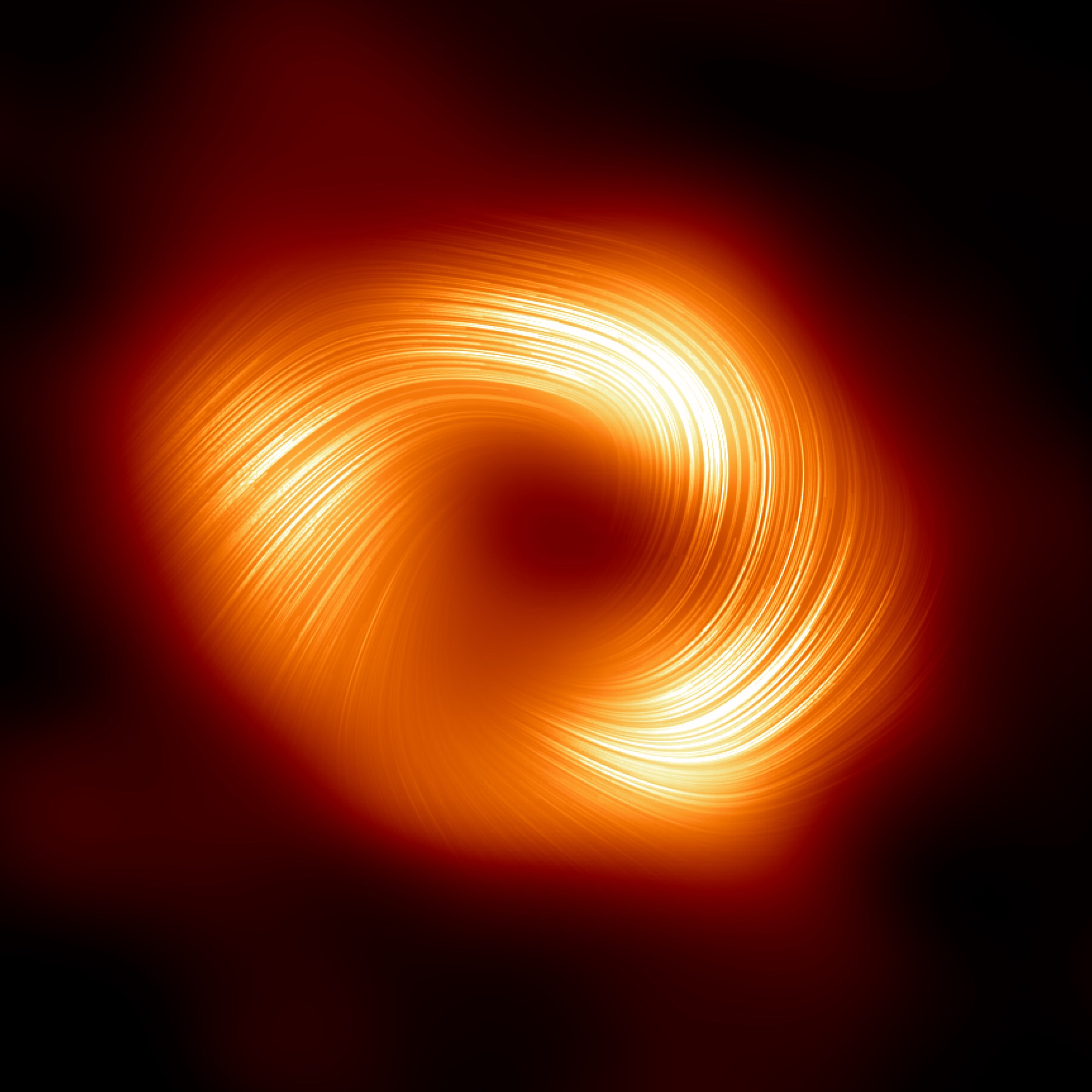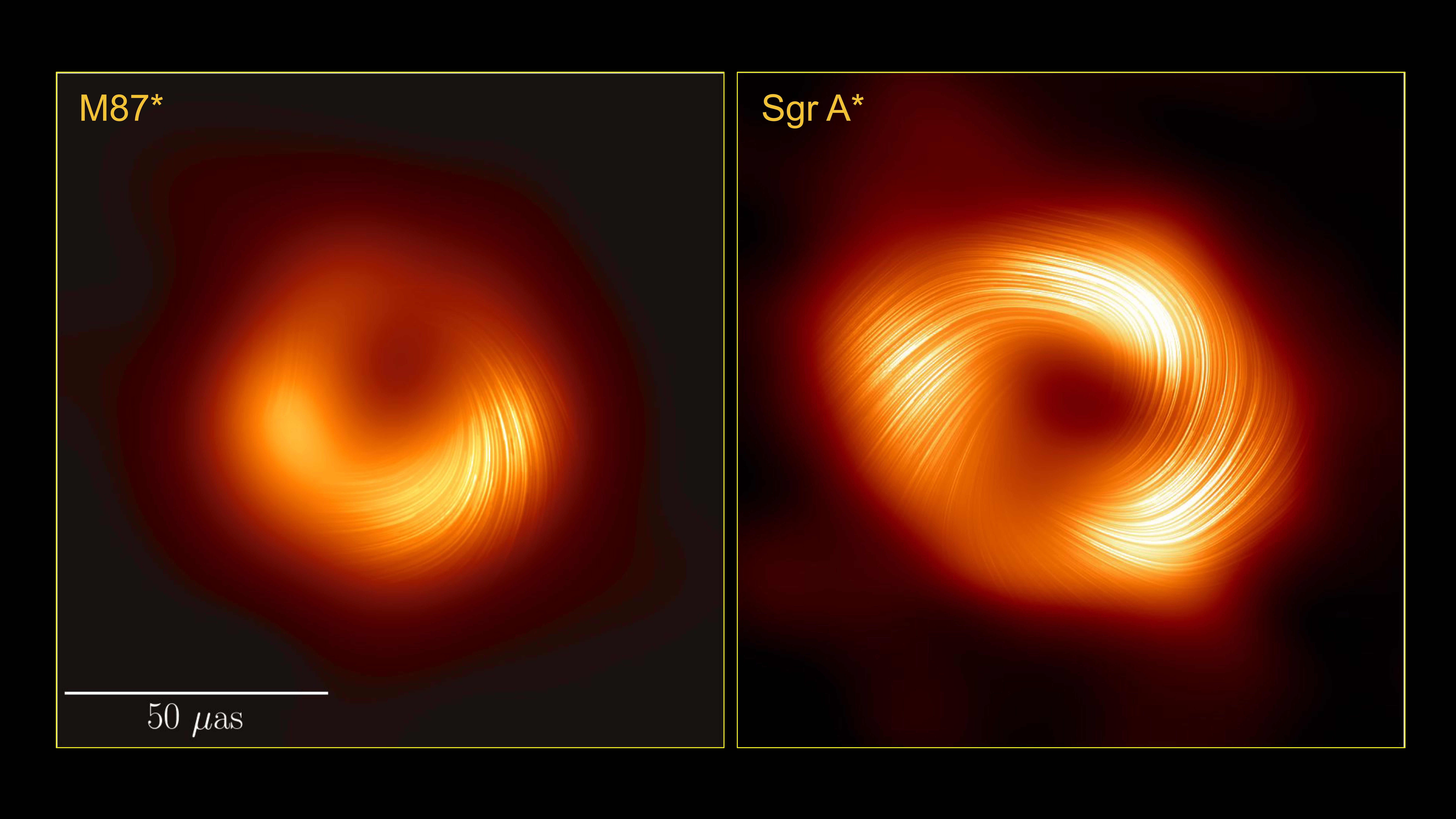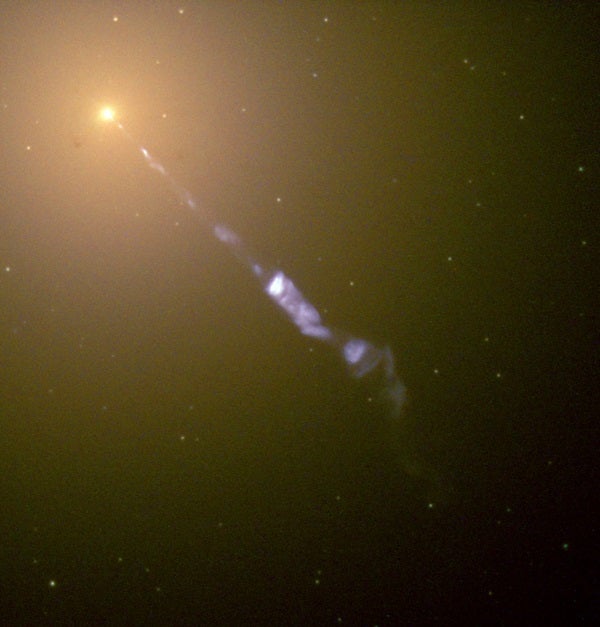
At 4 million times the mass of the Sun, the black hole at the center of the Milky Way Galaxy is rather humdrum, as far as supermassive black holes go. But a new analysis reveals that it’s a lot more like its larger cousins than scientists thought. It may even be able to harness its magnetic field to fire out a jet of material, a smaller version of the jets produced by the most powerful and voracious black holes.
These findings come courtesy of the Event Horizon Telescope (EHT), the same international team of researchers that in 2022 released the first picture of light bent around the Milky Way’s central black hole, which is called Sagittarius A*, or Sgr A* (pronounced “sadge A-star“) for short.
The new work reveals how that light is polarized, meaning how the electromagnetic waves that make up the light are oriented. This feature is imprinted on light by the black hole’s intense magnetic fields, and can tell astronomers how strong and organized those magnetic fields are. The team’s visualization of the polarization data reveals a pronounced spiral structure around the black hole, suggesting that Sgr A* has a surprisingly well-behaved magnetic field — perhaps orderly enough to funnel material into a jet, blasting gas and energy back into the surrounding cosmos.
Astronomers have yet to detect that jet, but if they do, “it might imply that almost every galaxy may have a hidden jet lurking at its center, but that we actually usually miss them because they’re simply too weak,” says Angelo Ricarte, a fellow at the Center for Astrophysics (CfA) | Harvard & Smithsonian in Cambridge, Massachusetts, and one of the leaders of the polarization analysis. And that in turn could have far-ranging cosmological implications, as the presence of a jet can greatly impact the course of a galaxy’s life.
The possibility of a jet hidden in our own galactic backyard is intriguing, says Yvette Cendes, a CfA radio astronomer who was not involved in the work. “Wow, the claim of a hidden jet will definitely keep theorists busy for years.”
The work was published today in two papers in The Astrophysical Journal Letters.
Eye of the storm
The EHT took its first observations in 2017 by training eight radio telescopes around the globe on two black holes: Sgr A* in the Milky Way and also the black hole at the center of the galaxy M87. By linking the telescopes together, scientists could obtain data with the effective resolution of an Earth-sized telescope.
Although M87‘s central black hole, M87*, is 55 million light-years distant, it’s also much larger than Sgr A*, appearing roughly the same size on the sky. And because it is larger, M87*‘s overall appearance doesn’t change as quickly, in the same way that a hurricane doesn’t change its appearance as quickly as a tornado.

This made processing the data for M87* much easier, leading the EHT team members to tackle it first. In 2019, they released their portrait of M87* — the first-ever image of a black hole’s shadow. They followed this up with an analysis of the polarization of light around M87*, published in 2021, which revealed a spiraling pattern of polarization.
Next up was Sgr A* — but its dynamic, ever-changing nature proved to be much more difficult to tame. In 2022, the EHT released their initial image of Sgr A*, which reflected an average of the total light acquired by the telescopes. “That was already a huge challenge because all the techniques we had developed for M87 were broken by Sgr A*,” says CfA fellow and project co-leader Sara Issaoun. (Issaoun led the observational aspects of the polarization work on Sgr A*, while Ricarte led the theoretical side.)
Soon after, the team turned to the even bigger challenge of extracting a polarization image from the Sgr A* data — but they had low expectations. “We didn’t expect to see anything,” says Issaoun. Polarization “is even more challenging than working with total light. And so there’s a lot more detail and a lot more care into extracting that information.” On top of that, the team also expected the relatively small size of Sgr A* to result in a weak, turbulent magnetic field, and therefore a chaotic and disorganized polarization signal.
But to Issaoun and her colleagues’ surprise, they quickly began to see signs of structure, much like what they had seen in M87*. The team then spent a lot of time fine-tuning their imaging software, training it on simulated observations. When they finally unleashed their upgraded models on the real data, the spiral structure “came out again super easily, and then we thought ‘OK, we got the real structure,’” says Issaoun. “Honestly, one of the most surprising things is that we actually managed to get something to show people and not just some statistical plots of what might be there.”
Other astronomers are struck, too, by the similarities between the two black holes. “It is surprising that Sag A* and M87* would have similar magnetic fields, as they are two very different supermassive black holes,” says Cendes. Just comparing the masses of the two black holes, “If Sgr A* were the equivalent of the mass of Earth, M87* on that scale would be a planet over five times the mass of Jupiter.”
A hidden jet?
Part of the reason that the strong, spiraling polarization signal was expected in M87* was that M87 has one of the hallmarks of an actively feeding central black hole: a big, bright jet beaming out from the galactic core at near-light speeds, powered by the black hole’s rotation and magnetic field.

By contrast, the Milky Way is not considered an active galaxy, and while previous studies have found evidence for a jet from Sgr A*, it has never been directly imaged. “So we were probably expecting something more like scrambled fields on the image, much weaker than M87,” says Issaoun. “But it turned out to be, again, this beautiful kind of ordered spiral.” And that strong, organized structure is best matched in the team’s imaging software by black hole configurations and magnetic fields that ought to produce a jet.
That’s not direct evidence for a jet, notes Ricarte. “Simulations can always be wrong — we really need to be able to see the jet before we believe it. But it‘s very suggestive.”
Issaoun says the EHT team thinks they can directly detect the jet in the next two years. “I think that’s going to be the next adventure for us,” she says. To that end, since the EHT’s initial 2017 observing run, the team has observed Sgr A* several more times, and also added three more telescopes to its array. The next time it fires up, it will also have the capability to observe at two new frequencies in addition to its usual frequency. This is the radio astronomy equivalent of being able to see the black hole and its associated features — the bent light from glowing hot gas and the magnetic field — in multiple colors.
In the long run, the team is planning a major upgrade, the Next Generation Event Horizon Telescope (ngEHT), with another 10 or so radio dishes over the next decade. Unlike the existing EHT, which consists of existing facilities, the ngEHT will feature dishes specifically designed for observing black holes and strategically place them around the globe in locations to boost the overall array’s resolution.
The hope is that the ngEHT will usher in an era of “black hole cinema” — capturing movies of black holes in both total light and polarization. That would let astronomers see “the direct connection between the black hole itself, the gas really close to the black hole at the event horizon, and the jet that flows out of it,” says Issaoun. “That, I think, will be super exciting and will bring us a huge amount of information about how black holes eat, how they launch these jets, how they generate these immense amounts of energy.”
The variability crisis
In the meantime, Sgr A*‘s surprisingly calm and disciplined nature will give theorists plenty to think about. The first hints of what University of Illinois astrophysicist Charles Gammie has dubbed “the variability crisis” emerged with the initial 2022 image of Sgr A* in total light, and the crisis is only deepening with the polarization data of our galaxy’s black hole and its neat spiral structure.
“Theorists are complaining that our data is too nice,” Issaoun quipped, speaking to Astronomy in a recent joint Zoom call with Ricarte.
“Yeah, this does mean that we might be missing something that is causing our simulations [of smaller supermassive black holes] to vary more than reality,” said Ricarte.
“Yeah, you have a lot of work to do,” responded Issaoun.
“We’re trying complicated things,” said Ricarte, “including making sure that heat flows more realistically in the simulations, adding extra viscosity that we weren’t accounting for before, and things like that.”
The variability crisis affects more than just our understanding of black holes. Theorists also think that jets play a key role in a galaxy’s overall life story, determining how long a galaxy can form stars. That’s because jets pump energy back out into a galaxy, which can blow away its reservoir of star-forming gas or heat it to the point where it can no longer collapse and make new stars.
Currently, said Ricarte, “the majority of cosmological simulations will only turn on a jet in more massive galaxies — ”
“ — like M87 — ” added Issaoun.
“ — often just by construction, because that is where we’re confident that we see the jets,” said Ricarte. “If they also exist in Sgr A*, that requires some kind of model modification.”
Soon, observers and theorists alike on the EHT team will have more data to work on: The collaboration’s 2024 observing campaign starts April 4 and runs through April 15.









